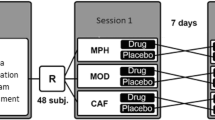Abstract
Rationale
Delayed matching-to-position and nonmatching-to-position procedures are widely used to model working memory in rodents. Mediating behavior—which enhances performance but is not explicitly required by the task—is generally considered an obstacle to the measurement of memory, but often occurs despite attempts to prevent it. The ubiquitous nature of mediating behavior suggests it might be analogous to rehearsal, an important component of learning and memory in humans.
Objectives
The aim was to study an easily recordable, rehearsal-like mediating response in rats under baseline conditions and after treatment with amnestic drugs [scopolamine (0.1–0.3 mg/kg) and delta-9-tetrahydrocannabinol (THC; 1–5.6 mg/kg)].
Methods
Lighted nosepoke holes were used to present position cues and record delayed matching or nonmatching responses. Performance of a distractor task was required to prevent simply waiting at the correct choice, but the nosepoke holes were left accessible during the delay.
Results
Each rat trained with the nonmatching task exhibited one of two mediating “strategies” that increased the odds of a correct choice: responding in the to-be-correct hole during the delay or responding in the opposite hole during the delay. Rats trained with the matching task all showed the former strategy. Treatment with scopolamine disrupted performance of the mediating response. Scopolamine and THC both decreased the effectiveness of the mediating response, increasing errors even on trials when the “appropriate” mediating behavior did occur.
Conclusions
The procedures and data analysis approach used here provide an objective, automated means of measuring mediating behavior, which might be useful as an animal model of memory rehearsal.





Similar content being viewed by others
References
Blough DS (1959) Delayed matching in the pigeon. J Exp Anal Behav 2:151–160
Bushnell PJ (1988) Effects of delay, intertrial interval, delay behavior and trimethyltin on spatial delayed response in rats. Neurotoxicol Teratol 10:237–244
Bushnell PJ (1990) Modeling working and reference memory in rats: effects of scopolamine on delayed matching-to-position. Behav Pharmacol 1:419–427
Chudasama Y, Muir JL (1997) A behavioural analysis of the delayed non-matching to position task: the effects of scopolamine, lesions of the fornix and of the prelimbic region on mediating behaviours by rats. Psychopharmacology 134:73–82
D’Esposito M (2007) From cognitive to neural models of working memory. Philos Trans R Soc Lond B Biol Sci 362:761–772
Dudchenko P, Sarter M (1992) Behavioral microanalysis of spatial delayed alternation performance: rehearsal through overt behavior, and effects of scopolamine and chlordiazepoxide. Psychopharmacology 107:263–270
Dunnett SB (1985) Comparative effects of cholinergic drugs and lesions of nucleus basalis or fimbria-fornix on delayed matching in rats. Psychopharmacology 87:357–363
Etherington R, Mittleman G, Robbins TW (1987) Comparative effects of nucleus basalis and fimbria-fornix lesions on delayed matching and alternation tests of memory. Neurosci Res Commun 1:135–143
Grant DS (1982) Stimulus control of information processing in rat short-term memory. J Exp Psychol Anim Behav Processes 8:154–164
Grant DS (1998) Directed forgetting in pigeons. In: Golding JM, MacLeod C (eds) Intentional forgetting: Interdisciplinary approaches. Erlbaum, Hillsdale, pp 239–264
Gutnikov SA, Barnes JC, Rawlins JN (1994) Working memory tasks in five-choice operant chambers: use of relative and absolute spatial memories. Behav Neurosci 108:899–910
Hampson RE, Deadwyler SA (2000) Cannabinoids reveal the necessity of hippocampal neural encoding for short-term memory in rats. J Neurosci 20:8932–8942
Harper DN, Hunt M, Schenk S (2006) Attenuation of the disruptive effects of (+/−)3, 4-methylene dioxymethamphetamine (MDMA) on delayed matching-to-sample performance in the rat. Behav Neurosci 120:201–205
Hasher L, Zacks RT (1979) Automatic and effortful processes in memory. J Exp Psychology General 108:356–388
Herremans AH, Hijzen TH, Welborn PF, Olivier B, Slangen JL (1996) Effects of infusion of cholinergic drugs into the prefrontal cortex area on delayed matching to position performance in the rat. Brain Res 711:102–111
Heyser CJ, Hampson RE, Deadwyler SA (1993) Effects of delta-9-tetrahydrocannabinol on delayed match to sample performance in rats: alterations in short-term memory associated with changes in task specific firing of hippocampal cells. J Pharmacol Exp Ther 264:294–307
Hunter WS (1913) The delayed reaction in animals and children. Behav Monogr 2:1–86
Jans JE, Catania AC (1980) Short-term remembering of discriminative stimuli in pigeons. J Exp Anal Behav 34:177–183
Mallet PE, Beninger RJ (1998) The cannabinoid CB1 receptor antagonist SR141716A attenuates the memory impairment produced by delta9-tetrahydrocannabinol or anandamide. Psychopharmacology 140:11–19
McAlonan GM, Dawson GR, Wilkinson LO, Robbins TW, Everitt BJ (1995) The effects of AMPA-induced lesions of the medial septum and vertical limb nucleus of the diagonal band of Broca on spatial delayed non-matching to sample and spatial learning in the water maze. Eur J Neurosci 7:1034–1049
Pontecorvo MJ, Sahgal A, Steckler T (1996) Further developments in the measurement of working memory in rodents. Brain Res Cogn Brain Res 3:205–213
Smith EE, Jonides J (1998) Neuroimaging analyses of human working memory. Proc Natl Acad Sci USA 95:12061–12068
Stanhope KJ, McLenachan AP, Dourish CT (1995) Dissociation between cognitive and motor/motivational deficits in the delayed matching to position test: effects of scopolamine, 8-OH-DPAT and EAA antagonists. Psychopharmacology 122:268–280
Unsworth N, Engle RW (2007) On the division of short-term and working memory: an examination of simple and complex span and their relation to higher order abilities. Psychol Bull 133:1038–1066
Acknowledgement
This research was supported by the Intramural Research Program of the NIH, National Institute on Drug Abuse. Thanks to Mark Good for comments on the manuscript.
Author information
Authors and Affiliations
Corresponding author
Rights and permissions
About this article
Cite this article
Panlilio, L.V., Yasar, S., Thorndike, E.B. et al. Automatic recording of mediating behavior in delayed matching- and nonmatching-to-position procedures in rats. Psychopharmacology 214, 495–504 (2011). https://doi.org/10.1007/s00213-010-2057-7
Received:
Accepted:
Published:
Issue Date:
DOI: https://doi.org/10.1007/s00213-010-2057-7




